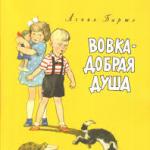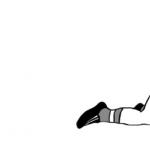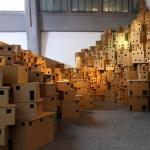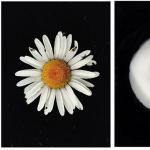"Swans in the garden"
I would like to bring to your attention a method for making garden swans from plaster.....I would like to point out that initially a video MK was prepared, but due to carelessness the video files and some photos were lost....maybe when creating the second swan I will still be able to edit the video.. ..
You will need
1: Wire d 5 mm
2: Plastic bottle 5l....square shape
3: Metal mesh

Using...in my case...a screwdriver.....we drill a hole in the lid for the wire...We place the bottle on its wide side on work surface, and cut off the top... Due to the loss of the files, I can’t show it figuratively, but in the photo you can see how the side of the bottle is cut off and I can’t show... that the end of the wire rests on the bottom.... Fill it with plaster.... Plaster I made the mixture liquid, it dries in up to 5 days, but it reduces the consumption of building material...

Next...I worked with finishing putty of the KNAUF brand....mix a portion of the mixture with a composition similar to a very thick porridge....if you are afraid that your mixture will dry out quickly, then before diluting the plaster with water....do this ....(small pack citric acid dissolve in one and a half liters of water....) and before pouring the amount of water you need, add a little acidic solution to the water and knead the mixture.....Put the mixture on an oilcloth along the length of the bottle.....put our future swan on a plaster surface flat cake...press down slightly and lift the excess from the sides up the bottle...in principle, as can be seen in the photo...

The point is behind the wings.....cut a piece of canvas from the mesh...about 12 cells long and 3 cells wide....apply it to the sides of the swan...at a slight angle...near the tail the lower part of the wing should be raised...we coat it with plaster and while the wings are drying a little...we move on to the neck.....spread the plaster all over the neck...with blobs...wet our hands and place the plaster mass on the neck....the first half of the photo. ...and then we wrap it with plaster...tightly and controlling the mass...so that approximately everywhere there is the same thickness..the second half of the photo
Under the mass of plaster, my wire slightly tilted to the side.... I fixed it on both sides.... after drying, it will no longer wobble to the sides but will stand straight.

Let's move on to shaping the neck.....walk a brush slightly moistened with water over the swan's neck...since it is completely dry..this will ensure easier attachment of the new layer...And as in the photo we transform the property of the swan....When when you reach the head, leave room for the beak and sculpt the shape of the head....after the shape is ready....fix a small piece of bandage on it....this way the mass will not crawl away anywhere

We give shape to the wings.....see photo

It’s not visible because of the bandages... but in the place where the swan’s wing was raised near the tail... we sculpt the fourth feather, so to speak

Tail....a piece of mesh fabric...bend it a little...depending on how you want the tail to lie or stand....fix it with a mass of plaster....by the way, I advise you to prepare the mass a little....let it more often... but it happens that the product needs to dry a little and there is nowhere to put the remaining mass (

As the tail at the base has dried out a little... we are preparing, so to speak, the foundation for the next work... we throw a little plaster on the top of the tail... photo...... and while the mass dries there we move on to the wings... look at the photo... .and with such mistakes we then form waves on the upper part of the wing....sometimes I wet my hands with water so that they could slide over the mass

Result

So...to secure the mass on the tail and wings, we apply bandages in scraps....Photo

We form the back.....by laying out a mass of plaster and rounding it...photo.....If you think that the plaster mass is floating in one place or another, apply bandages)))......

Let's put layers on the tail...photo...By the way, on the tail, after each layer of plaster, I sculpted a bandage)

And we move on to those parts where we have bandages applied... we need to hide them.... in this case we need a mass with the consistency of sour cream... and carefully lay and smooth out the layers with a brush... photo
Crafts made from gypsum are popular decorations for interiors and landscapes. summer cottage. Create original figurines for the dacha unique design and turn an ordinary garden area into a fabulous corner.
You can purchase decorative items made from plaster in the store, but the price for such decorations is quite high. Therefore excellent alternative option is to make crafts from plaster with your own hands, because it is affordable and not at all difficult. You just need to comply simple rules work with plaster and show a little imagination.

Gypsum - a material for creating masterpieces
When most people think of gypsum, they think of medicine, but it is also widely used in the chemical and paper industries, construction and handicrafts.

Due to the presence of certain characteristics, gypsum is a suitable material for creating various decorative items: carved borders, boxes, Christmas tree decorations.

It is not for nothing that museums contain many gypsum masterpieces of antiquity, such as statues, columns and animal figures.

Advantages of gypsum
Availability: You can purchase it at any hardware store at low price.

- Easy to use: just dilute the gypsum powder with water, pour the mixture into the prepared molds - and the original plaster figurine is ready
- Plasticity: the material can be easily molded the required form, both volumetric bases and miniature elements are created from it
- Environmental friendliness: is natural material, non-toxic
- Durability: a craft made from plaster will delight you for many years.





Fungus garden figurine (step by step instructions)
A common garden decoration is a mushroom-shaped craft. It is recommended to start your creativity with this figure, since it is one of the simplest.

In the future, having understood the principle of operation and studied photos of plaster crafts, you will be able to create more complex shapes.

To work you will need:
- Construction gypsum
- Plastic bottle
- Polyethylene film
- Wire
- Plate
- Acrylic paints and varnish






STEP 1. Make the gypsum mixture. To do this, you need to pour gypsum powder into a container with water and bring the mixture to the consistency of thick sour cream.

STEP 2. Making a mushroom stem. You need to cut off the bottom of the bottle. The remaining upper part is used as the frame of the leg.

Pour the mixture into the resulting container and insert a wire to stabilize the mushroom. When the plaster hardens, take out the resulting figure. To make this easier, the neck of the bottle can be cut. Don't forget to sand the leg.

STEP 3. Making the mushroom cap. Place on a plate cling film and fill it with the solution, place the mushroom stem in the center.

Thanks to the structure of polyethylene, the cap turns out to have small indentations and wrinkles - just like a real mushroom.

STEP 4. Paint and varnish. The product can be painted in any color, but it is better to use the shades of a real mushroom. It is also suggested to draw blades of grass on the leg, which will give the figure an even more natural look.

Funny eyes and a mouth painted on the mushroom cap will turn the fungus into a fairy-tale old forest man. This process will be especially exciting for children.

Let your child show his imagination and trust him to paint a garden mushroom: he will get creative, and you will have a pleasant and useful time together.

ADVICE. If you don’t have time to paint the finished figurine, you can immediately make it from colored plaster. To do this, first dilute the gouache in a jar and pour the solution into the water prepared to create the gypsum mixture.

Pour gypsum powder into the resulting colored water. This option is ideal for creating simple crafts, for example, a leaf, which, in turn, will serve as an excellent addition to the gypsum fungus.

As a leaf frame, you can use ordinary silicone molds, greased with oil.

As you develop skills in working with plaster, you will be able to sculpt more and more interesting crafts. The option for making a garden mushroom is based on the casting technique, which takes a minimum of time and effort.

The technique of sculpting from plaster is more complex, however, and products made in this way look elegant and unusual.

In addition, beautiful gypsum crafts can have not only decorative, but also practical function. For example, a flower pot sculpted in the shape of an animal figure will not only become a wonderful garden decoration, but will also serve as an original flower pot.

Photos of plaster crafts
















Plaster decorations will add individuality to your interior design. In addition, stucco can be used quite widely, in different styles room decoration. In the article we will tell you how to make stucco molding from plaster with your own hands (at home), we will give step by step instructions on production.
Selecting a figure
The variety of gypsum stucco today is not limited to the creation of figures of thick-cheeked cupids, graceful lines of flowers and petals, and indoor cornices. Using this material you can create an imitation of a fireplace, “grow” a tree on vertical surface walls or on the ceiling. The figure can be classically white or painted in various colors. The choice is determined by the wishes of the customer.
First of all, you need to decide appearance future work of art, its size, location. The best option– making a natural-size stencil or applying a design to the surface that you plan to decorate.
The options are endless. The simplest ones are stars, flowers, snowflakes, letters. You can decorate the room with original three-dimensional paintings - landscapes, still lifes. A “carved” frame will allow you to achieve complete imitation.
Solution
 For casting large gypsum products, the solution is prepared in small portions. The thick solution does not flow well and does not completely fill the mold, which has a thin relief.
For casting large gypsum products, the solution is prepared in small portions. The thick solution does not flow well and does not completely fill the mold, which has a thin relief.
An adhesive solution – gelatin or flesh solution – can slow down the hardening reaction. A 25% concentration of “glue water” is recommended. It must be used within one day. In addition, the use adhesive solution gives products strength.
Flat products are ground to flat surface, sprinkled with fine gypsum flour and leave them there for a day.
Manufacturing

Making stucco from gypsum can be done in several ways.
- The contours of the future composition are drawn using stencils. The gypsum mass is applied to the surface, leveled, and rubbed. Then all excess is trimmed off. If necessary, the procedure is repeated. This method is suitable for creating stucco with a fairly simple surface configuration.
- A solution is applied to the location of the stucco molding. Then the dried plaster is processed according to the drawing.
- Products with complex configurations are made using molds. They can be made of wood, plastic or concrete. First, the mold is generously greased with soap slurry. Then gypsum mortar is poured into it in layers. The maximum layer thickness is 1 cm. The next layer is poured only after the previous one has completely hardened. A well-hardened product is carefully released from the mold.

In addition, you can make the entire model or its fragments from plasticine. This material can change shape an infinite number of times. The plaster solution is applied to the finished plasticine decoration using a brush. Careful coating of the recesses guarantees the accuracy of the shape of the future product. Further layers are applied with a spatula only as the previous ones dry.
After an hour, the mold is removed from the plasticine model. When creating products of large shapes, it is reinforced with copper mesh. WITH inside the finished form is coated with colorless furniture varnish.
When pouring gypsum mortar into a mold, it is necessary to avoid the appearance of air bubbles in it. Light shaking will ensure that small reliefs are completely filled. Drying of gypsum products must be carried out at a temperature of at least +16 0 C. After thawing, they are destroyed. Do not try to speed up the drying process with a fan. heating devices- the plaster will warp.
Defects are eliminated with a knife, then the product is sanded with fine sandpaper.
The white plaster surface can be painted with paint on water based. Before this, it is covered with two layers of primer. Using pieces of cloth, sponges, synthetic materials You can give stucco any texture.
Surface preparation

The installation site of the future product is completely thoroughly cleaned and washed of whitewash. A notch on the back and mating surfaces will help to hold the fastening solution more firmly.
Small lightweight parts can be fixed using liquid plaster.
Large elements are mounted using special fasteners. Holes are drilled in them and in the surface of the wall or ceiling, into which, using dowels or wooden inserts screws are attached. Metal loops are fixed inside the plaster products. During installation, they are placed on the heads of the screws. The varnish coating will prevent the appearance of rust on the metal fasteners.
You can install metal pins into the wall, then they are pressed into the stucco holes filled with liquid mortar.
Before planning large compositions, it is better to practice by making small figures. You can also make decorations from individual modules.
Video
So, using a wooden machine, you can make a simple plaster stucco on one's own:
Photo







Today, making crafts with your own hands is quite simple. A variety of available materials helps to realize the most unusual ideas into reality. There are hundreds of master classes on the Internet, which include detailed instructions workflow.
Recently, beautiful crafts made from plaster have become very popular among novice handicrafts. The material helps create beautiful textured lines and takes on any shape. Finished products are durable. The surface of the craft can be decorated using acrylic and oil paints.

Our material presents creative ideas and instructions on how to make a craft at home. Advice from experienced specialists will help you avoid common mistakes when working with the material.

What crafts can be made from gypsum mortar?
What can be made from plaster? We present to your attention simple ideas crafts for beginners. These include:
- garden decor;
- figurines;
- photo frames;
- vases and beautiful dishes;
- small souvenir products.

Before you begin the manufacturing process, you need to familiarize yourself with the basic characteristics of this material.









These include:
- Dries quickly. The liquid solution hardens quickly upon contact with oxygen.
- Absorbs moisture. It is not recommended to install ready-made compositions close to bodies of water. Gypsum figures are highly hygroscopic. Prolonged exposure to a humid environment can cause mechanical damage to the surface of the craft.
- Good deformability. Plaster figures can be processed using special sandpaper. Thanks to this manipulation, minor errors can be corrected.

How to dilute gypsum solution?
Before you begin the work process, it is recommended that you familiarize yourself with the advice of experienced specialists who will help you properly prepare the gypsum composition for handicrafts.

Several types of solution are known. These include:
Simple option. To do this, dry gypsum powder is mixed with water in a ratio of 7/10. The solution turns out to be liquid. It dries quickly and can be further processed. Most often it is used to create photo frames and souvenirs.

More complex composition. To do this, you will need the following proportions: gypsum 6 parts, water 11 parts, slaked lime 2 parts. The finished product is quite strong. In the process of creating a craft, it is recommended to think about the future project, its shape and size. Incorrect pouring of the finished composition can cause cracks to appear.

Colored solution. Here, instead of slaked lime, a dye in the form of gouache is used. To completely dissolve the thick paint, it is recommended to stir the composition until the color is uniform.






Master class on creating garden compositions
We offer an interesting master class on crafts made from plaster. Specialized departments offer a wide selection of finished products. They differ in their shapes and sizes. Main disadvantage of these compositions lies in their cost.

Today, making garden decor is quite simple. There are many instructions on the Internet with step by step production DIY crafts. The design in the shape of a swan is especially popular among beginning craftsmen.

For this you will need:
- gypsum composition made according to method No. 3;
- large plastic bottle 5 liters;
- a plate in the form of a circle;
- roll of cling film;
- acrylic paints: red, black;
- metal wire for the frame;
- bandage.

The process of creating a product consists of several stages:
- U plastic bottle cut off the top part. We make a small hole on the side to fix the frame.
- Cover the surface of the plastic thin layer gypsum composition.
- We assemble the frame of the bird's wings and tail.
- On the sides we strengthen the wings and tail section with wire. We will strengthen them in the future gypsum mixture. Let it dry.
- When applying the next layers, use a bandage. It will add volume and strength to the product.
- When the surface is completely dry, it can be treated with sandpaper.
- Now we draw the beak and eyes of our bird. For brightness, acrylic dye can be applied up to 5 times.
- The final stage will be the application of protective varnish. The photo of a plaster craft shows the finished product.

Photos of plaster crafts



Note! 










Note! 










Note! 










Could there be something better than crafts, manufactured with my own hands? You can decorate your apartment with them and simply brag to your friends. Moreover, after planning it yourself, your item will be not just cute, but unique!
It is worth remembering that such souvenirs need special attention and accuracy. And the uniqueness of the product will become possible only after one hundred percent use of imagination. So, in this article we will talk about how to make gypsum crafts with your own hands. Will you try it?
Advantages of DIY gypsum crafts
Creating plaster souvenirs is a rather exciting process that can absorb you from the first minute. Moreover, such products are very durable and reliable, they can be stored for a long time in any conditions.
Video - ideas for plaster crafts
Required Tools
In principle, we don’t need too many things to create plaster crafts. Almost everything you might need is at hand. If you are determined and want to try yourself as a sculptor, then below is a list of the materials you need:
- Foil, you can even use regular food foil.
- Plaster for sculptures. The material is very durable, so it is ideal for our crafts.
- Plasticine, maybe for children.
- Plain water.
But materials are not all that we need in the process of work. There are also several tools that you should take care of in advance.
- Small iron or wooden plastic spatula.
- A container in which the solution will be mixed.
- A smooth board without any irregularities.
- A good office knife (if you don’t have one, a kitchen knife will do).
- A small painting brush with stiff bristles.
First stage.
At the very beginning, we take the prepared board, lay it on any flat plane and make the previously designed figure from ordinary plasticine. Next, using a knife, draw a line along the entire figure.
When we are done with this, we press small pieces of foil into the resulting lines. Of course, these segments must be as dense as possible.

Second phase.
We fill the tank with water, then add gypsum there. The resulting mixture must be constantly stirred until the solution resembles batter for making pancakes.
We can make all our own gypsum crafts from just this mixture. Next, we take a brush and cover the plasticine with plaster, slowly, one layer after another. In this case, each new layer is applied only after the previous one has hardened, and this order should not be violated.
Third stage.
The main criterion for how many layers need to be applied will be only the strength that you want to see in the future product. And when the last layer of plaster is applied, the souvenir must be left for a while to allow it to completely harden.
Approximate time - thirty minutes. After this period, everything unnecessary must be removed from the figurine, after which the product must be left alone for the second time (so that it is completely dry). And only after this the plaster mold will be removed from the plasticine matrix.

If everything was done correctly, and if the product is completely dry, then upon impact it will make a slight ringing sound. Next, we can decorate our souvenirs with something, or we can leave them in their original form. It all depends on your desire!
Video lesson - DIY plaster crafts
Other gypsum products.
In addition to the standard set of figures, you can distinguish yourself with originality and create something unusual. For example, a plaster Christmas tree decoration in the form of delicious cakes. To make them you will need cardboard, ribbons and, of course, plaster itself.

1. Draw several circles of the same size on cardboard. The dye must be added to the solution. After this, take an ordinary tablespoon and fill the resulting circles with plaster.

2. When the products are dry, their shape will need to be adjusted using iron molds. Then you should wait until the solution hardens completely.

3. Apply a little more plaster to the products. In this case, paint of any other color can be used, because this layer is a cream. After drying, attach a ribbon with a loop to the toy. Voila! Christmas tree decorations are ready!
Sea heart.
This is another unusual type of gypsum crafts. For it we will need heart-shaped shapes, cardboard, water, small pieces of multi-colored glass and, of course, plaster.
- Prepare the solution and pour it into our molds. The infusion should occur in a thin stream so that no air bubbles appear in the solution.
- After the plaster has hardened sufficiently (that is, it has the consistency of a thick dough), multi-colored glass should be laid out on it, pressing them in slightly.
- We wait until the solution has completely hardened and remove our products from the molds. The final stage is polishing shells or multi-colored glass, and that’s it - DIY plaster crafts can safely decorate your apartment!

We sincerely hope that all the tips written above will be an excellent assistant for you when decorating your apartment. After all, you can not only do crafts yourself - you can involve all members of your family in this. Each of them will be able to add something of their own, unique and inimitable.




